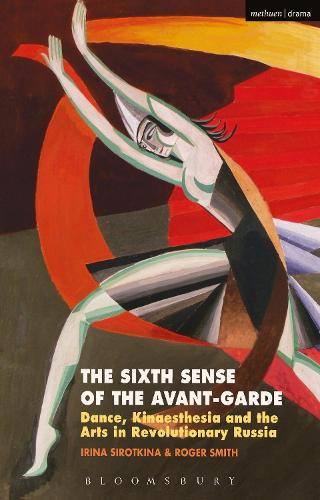
The Sixth Sense of the Avant-Garde: Dance, Kinaesthesia and the Arts in Revolutionary Russia
(Hardback)
Available Formats
Publishing Details
The Sixth Sense of the Avant-Garde: Dance, Kinaesthesia and the Arts in Revolutionary Russia
By (Author) Irina Sirotkina
By (author) Roger Smith
Bloomsbury Publishing PLC
Methuen Drama
20th April 2017
United Kingdom
Classifications
Tertiary Education
Non Fiction
792.80947
Physical Properties
Hardback
232
Width 138mm, Height 216mm
417g
Description
The touch and movement senses have a large place in the modern arts. This is widely discussed and celebrated, often enough as if it represents a breakthrough in a primarily visual age. This book turns to history to show just how significant movement and the sense of movement were to pioneers of modernism at the turn of the 20th century. It makes this history vivid through a picture of movement in the lives of an extraordinary generation of Russian artists, writers, theatre people and dancers bridging the last years of the tsars and the Revolution. Readers will gain a new perspective on the relation between art and life in the period 1890-1920 in great innovators like the poets Mayakovsky and Andrei Bely, the theatre director Meyerhold, the dancer Isadora Duncan and the young men and women in Russia inspired by her lead, and esoteric figures like Gurdjieff. Movement, and the turn to the body as a source of natural knowledge, was at the centre of idealistic creativity and hopes for a new age, for a new man, and this was true both for those who looked forward to the technology of the future and those who looked back to the harmony of Ancient Greece. The book weaves history and analysis into a colourful, thoughtful affirmation of movement in the expressive life.
Reviews
This book is a treasure chest of personages and practiceseveryone from Kandinsky to Blok, from Scriabin to Shklovsky, and multiple souls in between; everything from Dalcroze Eurythmics to the Foxtrot. It offers dynamic new ways to view the cultural history of this time. It all but exhorts its readers to go out and dance themselves. Many sources were crunched to make this books chapters, and many exciting roads lead out of them into future projects. * The Russian Review *
This volume examines kinesthesiathe sense of movementas a foundation of personal knowledge and cultural innovation, claiming primacy of kinesthesia over the other senses in that it affords unmediated contact with the world. Grounding their analysis of this sixth sense in historical context, Sirotkina and Smith reference the attraction of late-19th-century Europeans to ancient Hellenic life, citing a joyful universalism that particularly appealed to late czarist and revolutionary-era Russians. Evidencing the spirit of exuberant modernism, movementparticularly danceis seen as central to avant-garde culture, infusing poetry, mysticism, literary analysis, graphic art, and theater. Andrei Belys acute sensitivity to gesture becomes his verse, and Vladimir Mayakovsky is seen to compose posters, like poems, with his whole body. The celebrated artistic union of Sergei Yesenin and Isadora Duncan comes to life as a shining instance of the primacy of movement across the arts, and Vsevolod Meyerhold develops his biomechanical exercises for training actors. The concluding chapter projects the avant-gardists primacy of movement to present-day validation of kinesthetic experience as a vital source of knowledge. The translation is labored in places, but the extensive notes and suggestions for further reading compensate and make the book invaluable. Summing Up: Recommended. * CHOICE *
Author Bio
Irina Sirotkina is a lecturer at the Institute for the Theory and History of the Humanities, The Research University Higher School of Economics, Moscow, Russian Federation. She is a cultural historian who has published on the history of psychiatry and on the history of free dance. Roger Smith is Emeritus Reader in the History of Science, Lancaster University, UK and Associate Fellow at the Institute of Philosophy of the Russian Academy of Sciences, Moscow, Russian Federation. He is an internationally well known historian and philosopher of psychology and the human sciences, the author of standard texts in the field as well as specialist studies relating to the history of mind and brain and the understanding of being human, including Inhibition: History and Meaning in the Sciences of Mind and Brain (1992), and The Norton History of the Human Sciences (1997).
